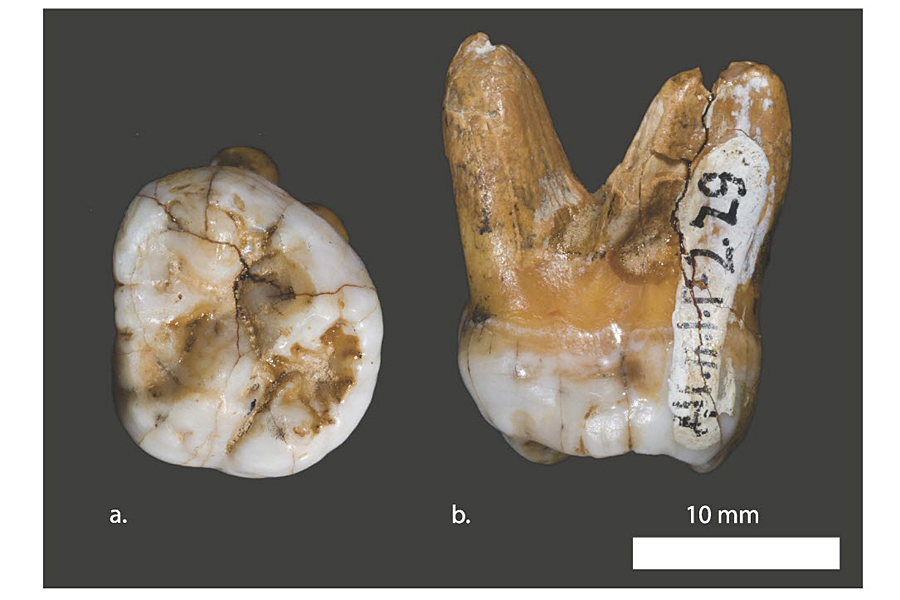Two ancient teeth reveal clues about humanity's mysterious cousins
Loading...
Before Homo sapiens ruled the Earth, other humans also roamed. Our famous extinct cousins, Neanderthals, once had cousins even closer to them: Denisovans.
The Denisovans are relative newcomers to the archeological family tree, being first identified only in 2008. All we know about comes from a few fossils unearthed in a single cave in southwestern Siberia, all of which so far have been dated about 50,000 years ago.
But a new DNA analysis of two teeth found in the cave suggests that Denisovans may have lived in the region some 60,000 years earlier than that.
The two teeth discovered in the Denisova Cave in Russia's Altai mountains are described and details hidden in their genome are revealed in a new paper published Monday in the Proceedings of the National Academy of Sciences.
“We got the first glimpse of genetic variation in Denisovans,” Svante Pääbo, director of the Max Planck Institute for Evolutionary Anthropology and one of the study's authors, tells The Christian Science Monitor in an interview. “And it turns out that they have quite a bit variation, about as much as Neanderthals.”
The teeth came from two distinct individuals, and one is quite a bit older than the other.
“We can sort of see that by detecting missing mutations that one of them is much older than the others, and we see that because it hasn’t accumulated so many mutations,” explains Dr. Pääbo.
“And,” he says, “It is in fact in the order of 60,000 years older.”
If their residence was continuous between the lives of the two specimens, the Denisovans lived in southern Siberia some 110,000 years ago to around 50,000 years ago. If not, then they moved into the region in the Altai mountains at least twice.
“This also shows that this enigmatic group, Denisovans, were present over a long time here in the Altai mountains in southern Siberia,” Pääbo says.
In 2010, scientists sequenced the genome of a finger bone found in the Denisova cave two years earlier, revealing the Denisovans as a unique species for the first time.
“Neanderthals and Denisovans share a common ancestor with present day people in the order of 600,000 years,” says Pääbo. But Denisovans are more closely related to Neanderthals than to us.
“Using our best estimates, they share a common ancestor in the order of 400,000 years back with Neanderthals,” he says. “Together, then they are the closest extinct relatives of present-day people.”
“Denisovans are still very enigmatic, since we know so little about them,” says Pääbo. “So with these two teeth now we have a little bit of feeling for their dental morphology.”
“These teeth are very large and they lack specific features that are typical of modern humans and typical of Neanderthals,” he describes.
Pääbo hopes by describing the teeth in the new paper the researchers will help other scientists identify specimens from other locations as Denisovan. “We might find other Denisovans in other places thanks to this,” he says.
Previous research has shown that Denisovans mixed with ancestors of modern day humans living in Asia, particularly populations in the Pacific. Papua New Guineans and other islanders in Oceania have been found to have as much of 5 percent of their DNA contributed from these Denisovans, Pääbo says.
That suggests that Denisovans lived all over the region, he says, because “we don’t think the ancestors of Papuans were ever in Siberia. Rather we think Denisovans were somewhere in southeast Asia where then Papuan ancestors met them and mixed with them.”
Another study showed Denisovan genetics appearing in another modern population. Tibetans living at high elevations have a Denisovan trait to help them survive.
“They carry genetic adaptation to living where there is little oxygen and that adaptation comes from these Denisovans,” Pääbo says. “So the ancestors of these guys mixed with the Denisovans, picked up this thing that allows them to live at high altitudes, and that is really probably a big contributing factor to why there are such big populations in Tibet today.”
Pääbo says his work is about discovering human history. “This is finding out things we didn’t know about our history, about our closest evolutionary relatives, which are now extinct,” he says.
“In a way,” Pääbo says of sequencing the Denisovans’ genomes, “It’s not so different from making an archeological excavation in a cave. We make sort of an excavation in the genome and find out things about history.”






